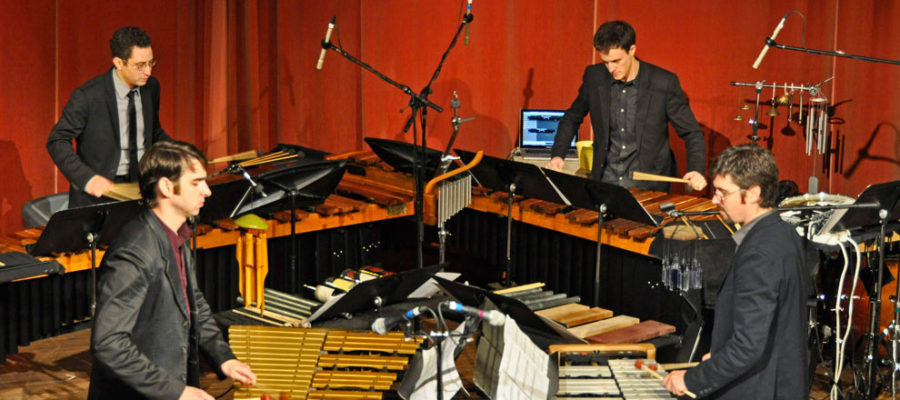The sounds coalesced into the skeleton of a music so much its own thing that it punched pain into my eardrums with its unfamiliar, lingering sharpness. And yet these same sounds worked together and were distinct, somehow both harmonious and not. As I sat two-thirds of the way back in the Logan Center for the Arts’s performance hall last Friday, I became, for the first time, the distinct, uneasy prisoner of an all-percussion ensemble.
The performance I found myself entombed in had the same atmosphere I imagine certain moments of the Professional Bull Riders circuit must have when you watch it live, in person, and close enough for moist flecks from off the bull’s nostrils to graze your upper lip.
This is not what I thought as I listened, caught up and enraptured on Friday evening, to Third Coast Percussion’s performance of Guo Wenjing’s “Parade”—the second piece of the night. But it is what strikes me now, as the thing continues to reverberate in my memory. This second piece was the most aggressively shrill of the three-part performance played that evening. A set of four blacksmith-men set about to hammering, really beating the hell out of six Beijing gongs laid out prone, flat, atop the face of a table.
That’s not to say the thing was all muscle and no silk. The four percussionists stood hovering—floating—across the table in such close, fevered proximity that the thing had an intensity both acute and weighty, made more so as the musicians, with their elastic fluidity, built crescendos that were left, faded, or killed off suddenly by their dampening of the humming gongs quickly with their palms.
This second piece ended with an onslaught of applause. Yet the real moment of the evening was a performance of Augusta Read Thomas’s “Resounding Earth,” which followed Wenjing’s “Parade” and an opening rendition of John Cage’s 1941 composition “Third Construction.” This was a special performance before the piece was begun.
Third Coast Percussion was in residence at the University all week, it seems, for this very performance. The diverse, seemingly endless strata of instruments (bells from all over the world, for example 25 different sizes of Japanese rin gong) were center stage, anchored on both sides by the previous instruments cast off. Thursday afternoon was a daylong seminar populated with faculty and student panels about the technical and historical implications of Thomas’s piece that I accidentally attended, mistaking it for the event itself. The piece was introduced as “her dream…to write a piece for bells only, because the sound of bells is so captivating [to her].”
It was indeed a special performance, and the highlight of the evening. David Skidmore, of the ensemble, would go on to say that “we’ll never have this level of collaboration again because Augusta is so wonderful,” referring to the relationship the musicians shared with the composer as she’d written the piece specifically for the ensemble. He related it to the shared work of composing, and of discovering the instruments—nearly 300 pieces of metal—from around the world.
There are four movements to Augusta Read Thomas’s “Resounding Earth.” When the first movement began the room was well lit, unlike during Wenjing’s piece, and so I could watch, enraptured, and take notes as the music came drifting into my mind. I was not scratching across the page vainly, in the dark, hoping the scratches made sense later.
I didn’t write anything for the first movement. I only recalled my pen and notebook, my seat and the hall, when the musicians paused in a solemn moment, dripping with the dying echoes from when the last bells struck.
They moved across the stage to take their positions—before the Japanese rin and spinning Burmese bells—to begin the second movement. “Prayer,” the movement’s title, haunted my thoughts as it unfolded. I found myself drifting somewhere along the line between dreaming and waking. The drugged song of vibrating bells went fleetingly to my brain through the landscape of slight coughs and small shifts of sleepy audience members. This was a meditative lullaby. There was an exhalation, an audible and felt sigh, as the movement drifted into a close.
The third movement found me still drunk off the second one. It picked up. There was a growing edge, a slow aggressiveness, that coalesced into the fourth movement, in which all of the bells across the length of the stage were played, the whole of the Earth’s sphere humming in that one room, to create an energy that was caffeinated, jittery, and yet still recalled the slow reflections of the piece’s second movement.
At the end, the collar of my shirt beneath my sweater was damp, and I couldn’t be sure if it was from the heavy jog I’d furiously made on the way over, or from the trip I found myself concluding in my seat.








